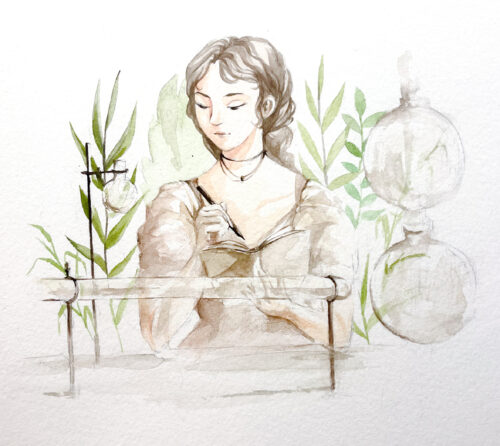Image Courtesy of Catherine Kwon.
Among the signatures at the 1848 Seneca Falls Convention for women’s rights is the name Eunice Newton Foote. With her name inscribed next to those like Elizabeth Cady Stanton and Lucretia Mott—both well known in U.S. history for their advocacy of abolition, women’s rights, and suffrage—she may seem like just another attendant at the convention, but her legacy was not fully recognized until just a few years ago. Today, we recognize her as the first person to recognize the impact of carbon dioxide on climate change, preceding John Tyndall, the scientist previously credited for this breakthrough.
Using a straightforward experimental setup, which included a cylinder, a likely glass, and thermometers placed inside, Foote concluded that carbon dioxide and moist air could absorb heat. Similar to how the glass in greenhouses can maintain heat inside its walls when it’s cooler outside, certain gases can trap heat from the sun in the Earth’s atmosphere. The significance of the greenhouse effect today is that rising carbon dioxide levels due to the burning of fossil fuels are contributing to climate change and global warming. Foote had made the connection that climate change is largely influenced by varying levels of gases like carbon dioxide and water vapor in the air; she subsequently published her results in the American Journal of Science and Arts in 1856. Her paper was also presented at a conference in the same year. However, Foote did not present her own article—it was uncommon for women to have done so. Instead, a summary of her work was given by Joseph Henry, who would later become the first secretary of the Smithsonian Institution. His summary would be found in almost every publication that presented Foote’s findings, while Foote’s original publication remained unrecognized. Even though Henry recognized Foote as an equal in science, her legacy’s absence suggests that others had minimized her contribution to the scientific community over time.
In 1859, about halfway across the world in Europe, Tyndall had also found that certain gases absorbed heat and immediately reported his findings to the Royal Institution. By 1861, he had carried out further experiments and published a paper. He had been one of several scientists who, like Foote, was concerned with the ability of certain gases to trap heat, and since then, he has received sole credit for the discovery of the greenhouse effect.
The mere five-year difference between Foote’s discovery and the publication of Tyndall’s paper raises questions about his omission of Foote’s name in his acknowledgments. Given that some publications in the U.S. would not have been widely read in Europe and vice versa around this time, it is unlikely that Tyndall took from Foote’s experiment and failed to give her credit.
However, this story still places Eunice Newton Foote’s name on the long list of women, like Rosalind Franklin, Katherine Johnson, and Mary Jackson, whose efforts in STEM went unrecognized for years, and in some cases, for decades or centuries. Foote’s story reminds us that women and nonbinary people continue to face discrimination, exploitation, and lack of due credit in STEM. Her presence at the 1848 Seneca Falls Convention was no accident—Foote understood that the world she lived in would not recognize her contributions as a woman, and she wanted to see that change. Being friends with Elizabeth Cady Stanton, Foote helped Stanton organize the proceedings of the entire Seneca Falls Convention. Her signature is fifth on the Declaration of Sentiments, a seminal work from the conference that demanded equal rights for women, including the right to vote. While recognizing Foote’s work is one more step in acknowledging the talents and contributions of underrepresented figures in STEM, it is a reminder that the field of science still has quite a long way to go.

